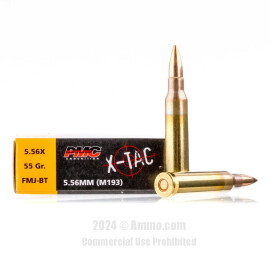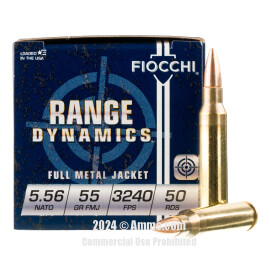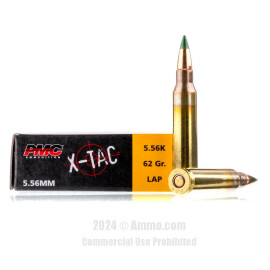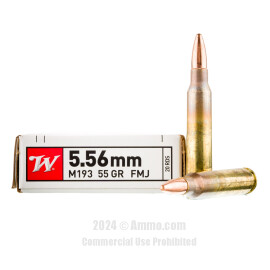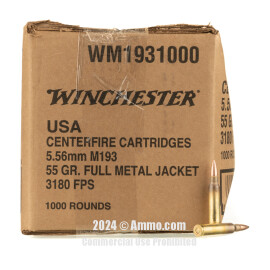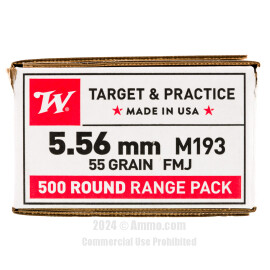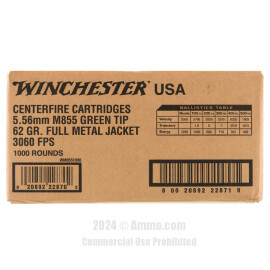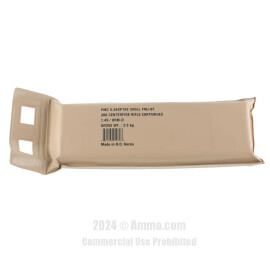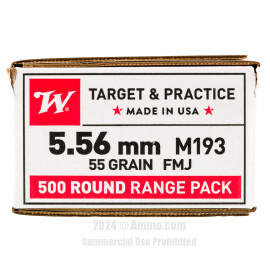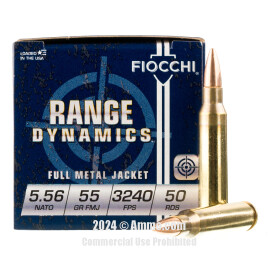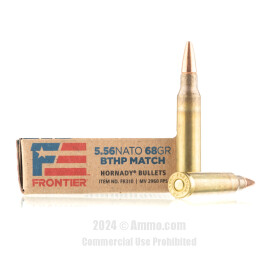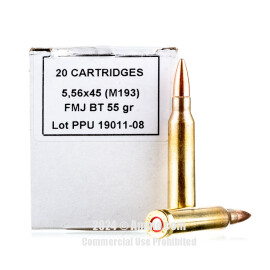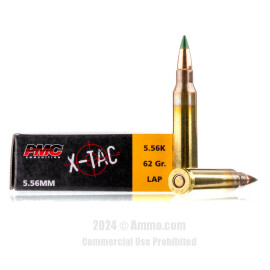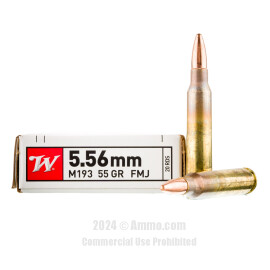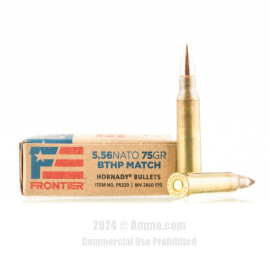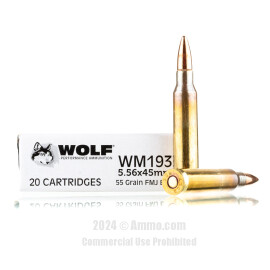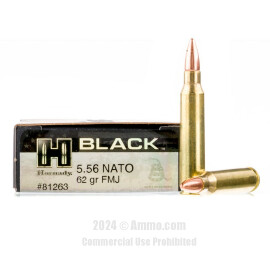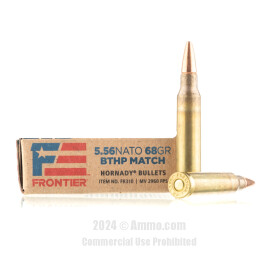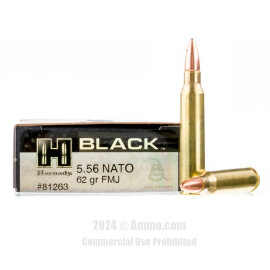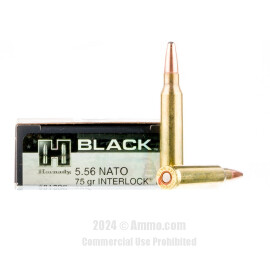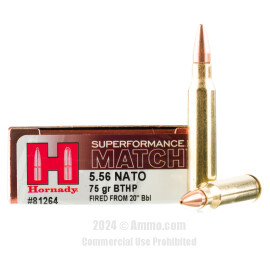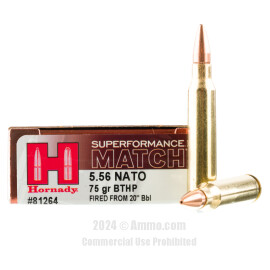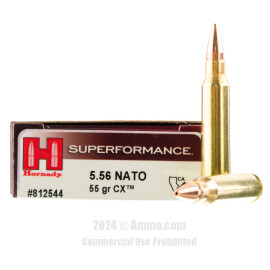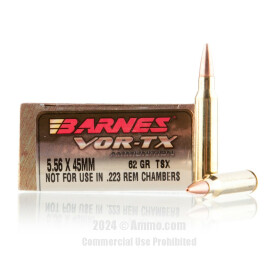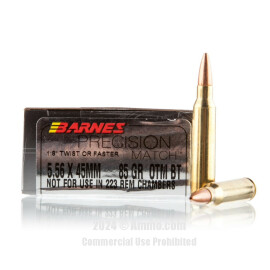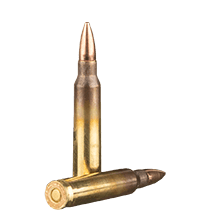
5.56x45 Ammo For Sale
History of 5.56x45 Ammo
Eugene Stoner developed the 5.56 NATO in the 1950s for the AR-15 platform, officially adopted by the U.S. Military in 1963 as the standard infantry cartridge. Its lightweight, high-velocity rounds allowed soldiers to carry more ammo without sacrificing effective range or accuracy.
Today, it's one of the most popular cartridges because of its low recoil, cost, and excellent accuracy, even in the hands of a relatively new shooter.
What are the most popular 5.56x45 brands you sell?
You can filter our entire selection using the left sidebar to see which brands we currently have in-stock and available using the Manufacturers filter. You can also filter by attributes such as Bullet Type, Bullet Weight, Casing Type, and Primer Type to find what you need.
Best 5.56x45 Ammo for Specific Uses
| Use Case | Details |
|---|---|
| Best 5.56 Ammo For Home Defense | Best Overall: Black Hills 5.56x45 62 grain Dual Performance. Runner-Up: Hornady Black 5.56 62 grain. |
You can also check out our in-depth look at 5.56 NATO ballistics from all of the popular ammo manufacturers if you're in search of ballistics data for your favorite factory 5.56 NATO load.
Customer Reviews
-
Joe said:
I am very pleased with their service, quick delivery and product. I have not experienced any issue with their product at the range. I highly recommend this website for all the above mentioned reasons.
-
A65impalla said:
I was glad to find that Ammo.com had plenty of stock of this ammo. I searched the net of a lot of places, their prices are very competitive.
-
twolazy said:
I have not shot any of this batch or the batch prior, I haven’t even opened the boxes. I’m in high hopes I never have to open these boxes. I’ve used Federal 5.56 before and it is good stuff. Price is stiff, not as stiff as some I’ve seen. But then everything gun related is more expensive, isn’t it. Get it while the getting is good.
-
Doc said:
I guess a shortage in the ammo supply has driven the price up, as I found your ammo to be a bit more expensive than I had anticipated.. Regardless, the delivery time was exceptional & the ammo itself came in good condition and preformed well.
-
Tommy said:
I have already recommended it, that being said, it is a bit pricey. But considering that there is such a shortage, I was happy to have it. I get a small disability check once a month, so, I'll have to save more money.
-
CJ said:
The order was handled quickly and efficiently. I would recommend Ammo.com to anyone who has stood in line trying to find ammo.
-
Adam said:
Good, Clean, ammo....pricey but what can ya do....fast delivery too I cant even find a die set to reload let alone the bullets or primers so this ammo will do untill times are better....if ever
-
deaves1 said:
5 stars
-
Don said:
Nice to know where to locate ammo after this BS of low production and high demand.
-
Joe-we-had-a-baby-it's-a-boy said:
Ammo was well packed, but the tins came in a bit banged up. Ammo was clean in good shape but stripper clips showed moisture damage with minor rust making it hard to load with the speed loader. The cost was deffently high and go figure right after I ordered I found 1000rnds of loose pack 62gr lake city for the same price as one tin of 420rnds, but finding 556 ammo these days is deffently a gamble of finding it and its price! Hopefully all this Bull will be over soon!
-
mrob6868 said:
Good and clean, but a little pricey.
-
nikpac said:
good clean ammo and a great overall value
-
trooper said:
This ammo package is over twice as expensive as it should be. If you don't reload your own .223 just go with Wolf...
-
jj said:
a good qalityt shell cida
-
Gilbert said:
good
-
Gilbert said:
good clean ammo sum what pricey but good over all
-
gokart04 said:
Finally got to shoot some of this the other day. Worked well and shot consistant/accurate. No feeding or fire failures out of about 100 rounds in my BCM AR-15. I feel the price is a bit too high at this time.
-
J.W. said:
These were the first rounds shot through my ar. I have no complaints, it cycles fine even through rapid firing. I would definitely buy these again.
-
H.D. said:
Works great, cycles fine, glad I found your sight.
-
Pat said:
This is excellent ammo. Velocity is up there, at least in my 20" barrel DTI ar 15. Kinda lucky to buy this cheap ammo and get it to shoot the way this stuff did. I love being able to buy metal cases as well as brass cases. The metal are non-reloadable and it's nice to just shoot these and not worry about looking after shooting. I worry about the future of buying ammo over the 'net in the future. Here in Illinois our great governor Quinn moves on every front to close the avenues to get ammo. Good Shooting to All
-
murdock said:
62 grain shoots just fine. no jams. but that old vietnam ak will fire, even when dropped in mud, and water. thanks Im just glad you had the ammo, and the price was right.
-
Mikey A said:
As usual very prompt customer service and worry free shipping, love these guys & gals @ ammo.com. Well I am no expert about ammo, but I will say that this ammo was performing better than some more expensive products. fresh and snappy, good penetration and groupings 2"-3" @ 200-300 yds, mini-14 1-9 twist , similar to SS109 m855 but heavier Gr.
-
Jt said:
Will buy again.
-
Rick said:
These rounds worked just fine.
-
Russell B said:
I ordered 2000 rounds and two ammo boxes the 50 caliber larger ones. The ammo boxes were brand new as promised and no signs of rust, sand etc. simply new. The 1000 rounds of 556 filled it almost to the rim. We pleased and will be back.
-
Shooter McGee said:
I searched many places for this product. You had the best price around, and the product arrived on schedule. Thanks for your great product and service.
-
Chris said:
Not only is the price fantastic, but my shipment arrived in pristine condition. I was a new customer, and didn't know what to expect. I had a very bad experience buying ammunition on line from another place that claims to be 'cheaper than...ahem.. anything'. My experience with Ammo.com could not have been better. The trusted brand and quality of my order goes without saying. But the handling, packaging, and service from the people at Ammo.com was phenomenal, even surprising given the world we live in where poor service is pretty much expected. I will not shop anywhere else. Ammo.com is my go to supplier.
-
Tim said:
Good price for ammo, not shinny but who cares its ment to shoot not to look at
-
Bill said:
I have tried different ammo with Sig 556. Its eats everything but I find Lake City 5.56 62gr --- No failures, Accurate @ 100 to 300 yards ( my club limits ) I have the feeling of complete depenability.
-
Russ said:
This is great ammo for the hybrid AR's.The brass is good for reloading and the 62 grain bullets stabilize well. Russ
-
Bobber1123 said:
Love the stripper clips. I think it took just 2 days to arrive. The price was excellent.
-
Private citizen said:
This is a great self defense ammo at a great price.
-
Christian said:
Shot 100 rounds through my new AR-15 and everything was flawless. Very happy with the service, delivery time and quality of the Ammo.
-
Ron said:
First time I used you guys and I'm impressed. Great prices,fast service. Keep up the good work.
-
Bear Patrol said:
Ammo comes in 5 plastic mini ammo boxes that look really neat! I wish the carry handles were real but they’re still worth holding onto for future use. So far I’ve put about 360 of these through my Windham HBC with no issues. As for accuracy I’ve only fired at targets from 100 yards or less from a standing position, so I’m not sure how they do at longer ranges but they always hit where I aim at those distances. The only downside for me so far is that I have to use paper targets or improvised targets (milk jugs, cans, etc.) Because these were leaving some SERIOUS dents in my 1/2 inch thick ar500 steel target. Overall I’d definitely recommend these to someone looking for decent 5.56 ammo at a good price.
-
Steven said:
The Ammo performed great. Consistent groups and accuracy. I experienced zero failures in the 300 rounds I fired. I used the ammo in a 1/9 twist barrel and Zerroed and Primary Arms LPVO in just 12 rounds. Once zeroed my shots stayed withing the 300 meter silhouette center mass circle. I'm verry impresssd. I did know what to expect since I always use the higher grain green tip from winchester. Many say you need a 1/12 twist barrel to get good performance from this ammo; I disagree.
-
Fiftysum said:
I just bought a Colt LE6920 5.65 caliber. The closest thing I ever shot was my M16 when I was in the Army during the Vietnam era -- a long time ago. So my review is not based on a comparison with any other ammo brand in this caliber. I bought Winchester because it is a known brand, is labeled for target use, and I feel it was available for a good price here on Ammo.com. I know there are some premium brands, which I will try eventually, and there are lots of brands I never heard of. Some of them may be good, I just don't know anything about them yet. I'm giving the Winchester 5.56 target ammo five stars in each category because my shots were consistently within one inch of the bullseye at 25 and 50 yards. That I hit the target at all at 100 yards I will count as okay because I didn't have a scope and I could just barely make out the 100-yard target with my not-so-good-as-when-I-was-20 eyesight. I qualified "sharpshooter" when I was in the Army, having missed "expert" by one shot. It makes me happy that this Colt M4 is as accurate, if not more so, than my Army M-16. Good ammo should give consistent results. This Winchester target brand delivers for me.
-
Capt AR said:
Spent 30 rounds @ 100 yrs.Fired prefect and only a couple off Mark.
-
Darrell said:
Man this ammo can in, in a matter of days nice quality
-
Jetson said:
Goes bang, burns clean, shoots straight no ftf’s or any other issues. I’d trust my life to it. Gonna get more.
-
Cameron said:
Great shipping shoot fine at 100 yards could drill dime every shot
-
Lu said:
Glad I got it
-
Chrisp280 said:
Super impressed with this company
-
Gabe said:
I was looking for inexpensive practice ammo,and this was a good deal all around. Ammo was a good price relative to the times.Checkout was easy. Ammo was delivered quickly. Only had time for a100 rounds , no problems. Really like getting the ammo can too.
-
Blake said:
Excellent ammo. Very accurate from the AR and bolt gun. Will be buying more.
-
Rysio said:
Very good ammo although it is Russian. Performs as expected no problems.
-
THL said:
Took it out in my tavor, with a 14x primary arms scope, shoots about 2 MOA off of a bench in quick fire. Not too shabby for a HD OTM round rather than the match BTHP rounds
-
Tim said:
Military grade green tip ammo it has a steel core and is magnetic. perfectly annealed brass boxer primed reloadable cases. It is a bit pricey at $1.19 per round after shipping . So it's not for people with short pockets or shooting at worthless paper. These get stored with my zombie apocalypse or S.H.T.F ammo supply Would buy again just because you can never have too much ammo ????
-
Joe said:
Really good on the range. haven't had a problem yet
-
michael said:
Ok
-
RONALD said:
No surprise here but the price per round shows as 63.8 cents. With shipping and sales tax, that easily went to about 85 cents. I did receive it in a timely fashion and it was well-padded in a cardboard box but would have preferred different packing from the factory. My error. A range pack means loose rounds inside a box. The ammo itself is so-so for its intended purpose. I also purchased Belom 7.62x39 (no longer available here) and cannot address ammo quality yet, but the factory packaging (20 rounds per PLASTIC case) was phenomenal.
-
Robert B said:
This Ammo shoots well, However when trying to reload the brass I broke 2 decapping pins in my sizing die. I cut the head off two cases and found the flash hole is off center. So even though the ammo shoots well it cannot be reloaded.
-
Jamms said:
Price was pretty good. But constant jamming and feeding issues in all 3 of our weapons. Casings seem soft. Not sure about that though. They did stay in decent groupings on the target at 50 yards. Oh and the damn boxes all came apart, had to just dump em all into a bucket. Frustrating because I like to just take one or two boxes to the range. But anyway.
-
Josh said:
Had two days of rifle training scheduled with a paid group. Both training classes cost around $1,000 for both days so the issue is when you pay for training you need ammo that will perform so that way you don't have to worry about missing out on what you've already paid for and this ammo did that! Not one misfire out of every round of the thousand purchased. Nice to be able to still find quality products out here.
-
Kyle said:
I've used about 200 rounds and it works flawlessly.
-
Just a guy ~ said:
This is my favorite 5.56 cartridge, hands down. Every component is top quality & PMC doesn’t cut corners. I’ve shot them all and this is the most accurate & reliable 5.56 factory cartridge. I prefer the 193 - wish it was 62 or 69 grains… The brass is excellent & should absolutely be kept for reloads (I safely get 3 reloads per). A small shop by me sells it for $8.99 a box in 2023… That’s a steal. Have fun & remember that firearms safety is 100% on us.
-
Ron said:
I like PMC Ammo the 5.56X45mmNato is what I shoot. Great for range, self protection, The reason I purchased this ammo is because of who makes this.
-
Kenneth said:
couldnt find ammo locally so i checked the net fully expecting 2-3 wks for delivery. ordered early on a saturday morning. was on my door step monday. impressive
-
txweld said:
All good
-
Runner said:
PMC is a very reliable ammunition , I would not hesitate to use if for self defense. It shot well and now that I have shot it and used it all, I`ll need to order more. BTW , I use PMC in my handgun for home protection and it is as good as it gets and the 5.56x45 is as great .
-
MM said:
I shot about 200 rounds through my brand new SIG716. The very first 3-4 rounds wouldn't feed perfectly, but I attribute this to the brand spanking new equipment. After that, rifle and ammo performed flawlessly. Not a single issue with feeding, cycling, firing, etc. At 150 yards, I had all shots within about 2-3 inches using a cheap scope and no rest. Great product and especially GREAT SERVICE! Thank you guys!!!
-
D said:
Great customer service, placed the order last friday fully expecting not to get the order with all that is going on, you won't find a better company to deal with, as for the Ammo, top notch perfect for my use.
-
CowwFace said:
I got this for taking to the range, went through about 100 rounds and zero duds. works perfectly in 2 AR's. We were using Red-Dot scopes, and hit what we were aiming at about 100 yrds away. I would highly recommend this ammo.
-
Mr honest...!! said:
I used to 556 boat tail full metal jackets to practice and hone my skills...!! If and when I have to rely on my ammo to save my life , my 30 round mags will hold the Fiocchi fmghp brand in a 69 grain....!! Thank you Fiocchi for producing a superior quality of ammunition at a reasonable price...!! Sincerely Mr Honest P.S. I am a real person , a 50 year old single father with three daughters living at home... This is no BS review , I'm as real as you...!!
-
Bone Crusher said:
Shoots straight, flying fast.
-
T-bag said:
For the price and quality, never thought I'd be using green tips as target rounds. My AR hasn't jammed up yet after 100 rounds or so, which is impressive. My AR is very picky on ammo, usually can't get 30 rounds out without a couple jams. But this stuff runs like butter through my AR, with some impressive penetration to boot.
-
Mick said:
All ammo went down range with consistent velocity and tight groupings. Previously purchased ammo from another party had poorly seated primers, this jamming my fire arm.
-
olbull said:
same as title
-
john said:
good product / good price
-
Snake said:
Great ammo! Shoots and cycles perfect. Will defiantly buy more.
-
lroberts103 said:
Great company to work with. Fast shipping great price
-
Michael said:
This 5.56 ammo was just what my AR needed.
-
Justis said:
I've used Winchester rounds in other calibers and never been disappointed by them, and I can say the same for these 5.56 rounds. Excellent training rounds, good pricing, and I've had no issues with the first 450 rounds I've used so far.
-
D. said:
Was very happy with proformance of Winchester 556.no jams with 2 ARs.will be making another purchase very soon.Thanx much AMMO.you have great sales.
-
Jacob said:
The rounds were dirty, with some having excess powder or some kind of processing oil/grease on them. A few boxes had 18/19 rounds in them. Worked well in my rifle after 500 rounds so far and were a good price.
-
B.S said:
Shot 250 rounds , no isues.
-
Jona snow said:
Great rounds , not one miss fire
-
kevinjc73 said:
I have a Ruger AR556 in which Ive shot 200 rounds of Winchester 193 556 with no problems accurate at 50, 100 and 200 yards
-
Jeffrey said:
Otherwise there reliable an they are fast like 2900 t0 3100fps
-
Thomas said:
Shot 150 rounds no misfire no gun jam good pattern
-
John said:
Outstanding job, I will use this company and tell my friends.
-
jerry said:
great ammo
-
Karl said:
For the price I'd say a good purchase. Out of 200 rounds maybe around 15-20 rounds that I'd assume had bad primers and didn't fire.
-
BWalter82 said:
This ammo is clean firing, accurate to 2 moa, and I never had a problem in any of my rifles; probably the "best bang" for the buck out there!
-
Nate said:
The ammo itself LOOKS beautiful compared to Lake City penetrators but I have not shot it yet so I can't comment on that. I paid more per round, but that is just the market, not Ammo.com.
-
Bigthiss said:
Great ammunition for the price. I used to buy the federal loose bulk ammo in 500 and 1000 but there were always at least 10-20 that were either faulty loads or misfired. This ammo is hands down the best for the price that I have purchased and shot. Highly recommend!!
-
Matthew said:
Ammo was inexpensive and dependable. Shipping was on time. Would definitely recommend.
-
CAP said:
Great ammo, Accurate, shot 11/2” Group at 300yrds
-
Cody said:
Best 62 gr round Ive used. I shoot a .223 Wylde barrel on a AR -15 used for matches. These perform close to as well as hand loads made for the rifle. I would use them for more than practicing anytime




